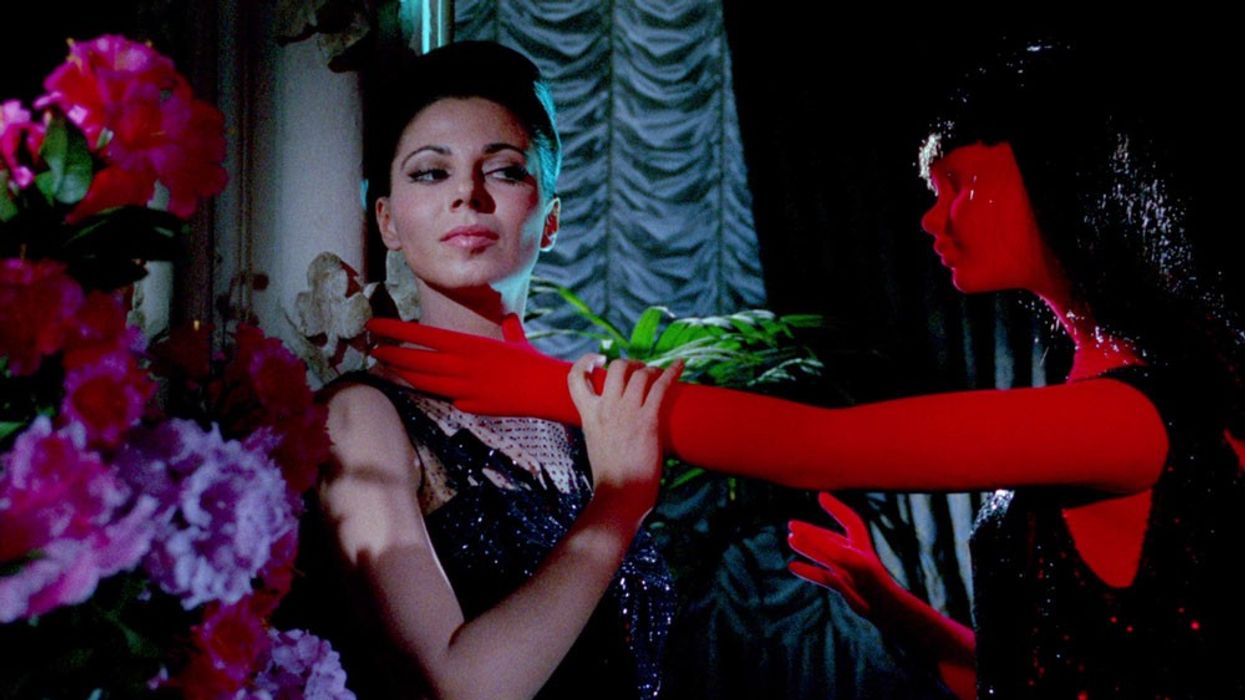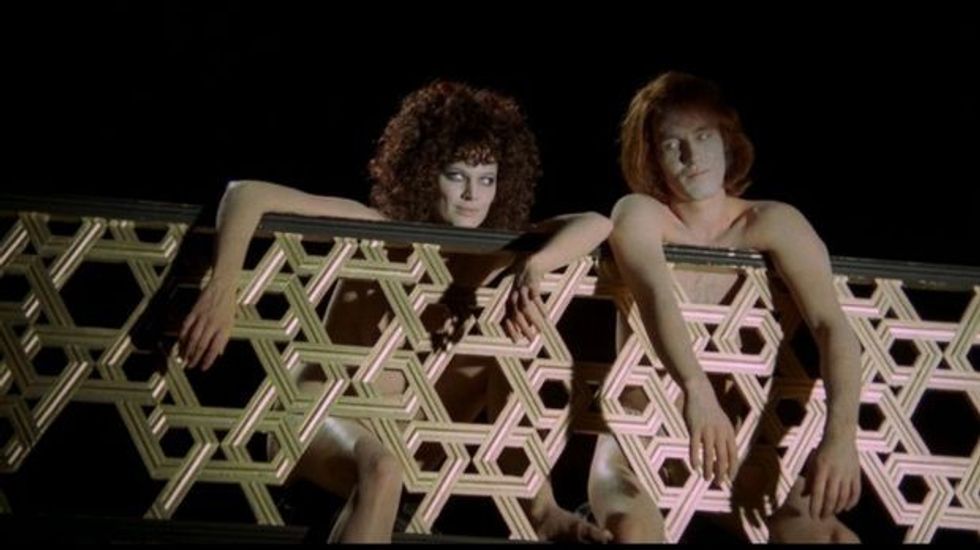What is a Giallo Film? (Definition and Examples)
This underrated genre redefined horror and murder mysteries.

Horror is a genre that is always excellent and strange no matter where it’s from, and Italian horror is no exception, especially the specific genre called giallo.
This is a tricky genre to encapsulate simply because the filmmakers of the genre don’t want their work to be defined. The simple plots and high body count blended with a highly stylized visual language have gone on to inspire the slasher genre we know and love today, as well as many of our favorite directors.
Today, we're going to define giallo films, dig into the genre, and look at some examples.
Let’s get into the distinctive elements that you can use in your next horror film.
What Does "Giallo" Mean?
The word “giallo” (“gialli” when plural) means “yellow” in Italian. The term was used to reference the cheap paperback mystery and crime-thriller novels published by Mondadori since 1929.
The novels, with their infamous yellow covers, were hugely popular in Italy, and the term “giallo” became synonymous with the mystery genre.
What is Origin of the Giallo Genre?

'The Girl Who Knew Too Much'
Credit: Warner Bros.
A giallo film is often credited to 20th-century Italian murder-mystery films which contain elements of both horror and thriller regardless of their national origin. Many English speakers use the term to specifically refer to a genre of Italian-produced thriller-horror films, also called "Spaghetti Slashers," with filmmakers like Mario Bava, Dario Argento, and Lucio Fulci coming to mind as masters of the genre.
The giallo genre began as literal adaptations of the original giallo mystery novels with the 1933 film, Giallo. Filmmakers soon saw the genre as a place to experiment with cinematic techniques that played with the audience’s psyche, creating films that were filled with paranoia and perversion.
The genre thrived between 1968 and 1978, eventually losing steam in the ‘80s. While the genre isn't as popular as it once was, filmmakers are still creating these gialli films today.
The Elements of a Giallo Film

'A Lizard in a Woman's Skin'
Credit: Fida Cinematografica
Giallo films are hard to define due to their thematic and stylistic nature. As you could tell by the definition of a giallo film, the genre is broad and breaks away from fixed genres.
Toni Stranger discovered that the main elements of a giallo film are:
- Lavish set design with vivid, bold, surrealist qualities
- Exceptional costume design
- Acts of violence
- Nudity and eroticism
- Psychosexual desires from the killer and other forms of psychological madness
- A murder mystery involving a disgraced detective
- Red herrings
- Beautiful middle-class women who have their lives either interrupted or ended
- A menacing soundtrack
The giallo genre took off with Bava’s The Girl Who Knew Too Much. Although the film lacks sexuality and violence, the film is often credited with establishing the structure of the genre.
Bava’s most influential giallo film, Blood and Black Lace, came out a year later and grounded the genre. The masked killer with black gloves and a shiny weapon used to murder glamourous middle-class women for psychosexual motives became the defining traits of the giallo genre.
Argento, another influential giallo filmmaker, helped define the style of giallo with his surreal visual style with films like Suspiriaand The Cat o' Nine Tales.
It should be noted that gialli films often involve crime and detective work, but they do not involve films that are more action-oriented about violent law enforcement officers like Dirty Harry, Death Wish, and The Godfather. Instead, they are whodunit slasher films.
The Tropes of Giallo

'Four Flies on Grey Velvet'
Credit: Cinema International Corporation
Two of the main tropes that gialli films are mainly concerned with are the masked killer and the psychotic women.
The giallo killer is someone who is disguised in some way to protect their identity. Since gialli films are essentially whodunit slasher films, the murderer’s identity must stay hidden until they are unmasked in the climax of the film.
The origins of the giallo killer can be found in Blood and Black Lace, where the killer wears a fedora and some material over the face. In Strip Nude for Your Killer, the killer wears a motorcycle helmet to disguise himself. A trenchcoat and yellow gloves were worn by the killer in The Case of the Bloody Iris as a nod to the origin of the word “giallo,” which are also motifs found in gialli.
The killer is typically an unsuspecting male character with a psychosexual desire for the beautiful women he is after, and their identity becomes more and more complex as they murder their friends or partners. Sometimes, the protagonist will be revealed to be the killer.
The second common trope of gialli is the “psychotic women” trope. The theme comes from the childhood trauma that the women have suffered from at some point, complicating their past and rounding out the characters. While the term is outdated, gialli women are fleshed-out characters who are driven by their desires.
In Four Flies on Grey Velvet, the protagonist, who is revealed to be the killer, explains to her husband that he reminds her of her father who beat her as a child and said she was crazy. The father put her and her mother into an asylum, which is where her mother died. Her trauma was triggered when she met her husband, and she knew she would kill him as a cathartic sense of revenge on her father.
The Visual Style of Giallo

'Deep Red'
Credit: Rizzoli Film
One of the most important elements of the genre is its appearance. Filmmakers like Bava and Argento set the standard for the visual elements associated with the genre, using bold and vivid colors that complement the lavish set design and stylish camera work.
The sets are often surreal and dreamlike instead of the constant dreary and grim palettes that are often associated with standard horror and thriller films.
The cinematography of giallo can be described as a candy-colored nightmare with its hues of pinks, reds, and blues that are used to build tension.
Argento’s Deep Red features red as its single prominent color to highlight the key aspects of the film as well as the blood that often shows up.
Giallo is all about crafting a style that can be used as a technique to serve visual storytelling.
Examples of Giallo Films
Here are some classic examples of Giallo films:
- The Bird with the Crystal Plumage (1970) - Directed by Dario Argento, this film is often credited with popularizing the Giallo genre. It involves an American writer in Rome who witnesses an attack by a mysterious assailant dressed in black.
- Deep Red (1975) - Also directed by Dario Argento, this film combines a complex whodunit plot with graphic violence and suspenseful music. It's considered one of the best Giallo films for its innovative cinematography and chilling score by Goblin.
- Don't Torture a Duckling (1972) - Directed by Lucio Fulci, this film diverges from the typical urban setting of Giallo films and is set in rural Italy. It's a critical take on societal issues, blending a murder mystery with commentary on religion and superstition.
- Tenebrae (1982) - Another masterpiece by Dario Argento, this film follows an American author in Rome who becomes embroiled in a series of murders that mimic the killings from his novel. It's notable for its inventive camera work and brutal murder scenes.
- The Strange Vice of Mrs. Wardh (1971) - Directed by Sergio Martino, this film combines elements of eroticism with a complex plot involving a series of murders. It's known for its stylish execution and has become a cult classic.
- Bay of Blood (1971) - Directed by Mario Bava, this film is considered a precursor to the slasher genre. It features a series of gruesome murders connected to an inheritance dispute and is known for its graphic violence and convoluted plot.
- Blood and Black Lace (1964) - Also directed by Mario Bava, this film is one of the earliest examples of the Giallo genre. Set in a fashion house, it follows a masked killer murdering models to retrieve a diary that contains damning secrets.
These films are essential viewing for fans of the Giallo genre, offering a mix of suspense, horror, and mystery, along with the stylistic flair that makes Giallo films distinct.
Summing Up the Giallo Film Genre
Giallo is a tricky genre to encapsulate because of its desire to experiment with the murder mystery genre. While most people think of horror, most notably slashers, thrillers, and crime when they hear giallo, the term is more defined by its stylized approach to subversion.
If you want to incorporate some of the Gialli elements into your next project, I recommend studying Eli Roth’s filmography as it is heavily influenced by Giallo, as well as many of Hitchcock’s murder mysteries, which both influenced and were influenced by the genre.
Remember, it’s all about style and suspense, so go as big as you can while creating your Giallo film. What's your favorite giallo film?
Let us know why in the comments below!










![Ethos, Pathos, Logos: 20 Effective Ways to Advertise [Infographic]](https://nofilmschool.com/media-library/ethos-pathos-logos-20-effective-ways-to-advertise-infographic.jpg?id=34064614&width=600&height=600&quality=90&coordinates=560%2C0%2C0%2C0)

